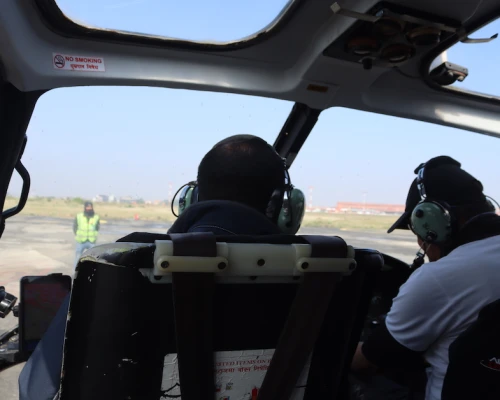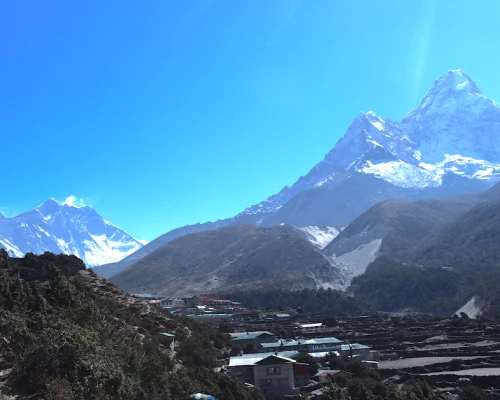Everest Base Camp Trek from Dubai is our full board 13-day package with a helicopter return from Gorakchep to Kathmandu. Hike to Kala Patthar at 5,555 meters and Everest Base Camp at 5,360 metersfeels like achieving a lifetime award. The trek starts from your local city. You will be on a journey towards the base camp of the world's highest peak, Mount Everest. Designed specifically for adventurous souls in Dubai, this trip will take you on an excursion through the might and majesty of the Himalayas.
The package inclusive of bothway flights to Kathmandu and from Dubai, accommodations, airplane transfers to Lukla, qualified guides, porters and permits, and any additional accessories needed on the odyssey. This complete set makes the trekkers comfortable, safe, and happier.
The trek's route spans thirteen days, which is sufficient for acclimatization, rest, and sightseeing. The hikers start by riding an incredible air travel from Lukla to Kathmandu.
After that, it passes through a stretch of thick forest with many overhanging ones and several picturesque Sherpa settlements, including a famous one, Namche Bazaar, which is a gateway into this land. From Namche Bazaar, you trek towards Dingboche and Lobuche.
The last couple of kilometers of the trek are traversed by trekkers, ending at Gorak Shep village, the last settlement before the base camp.
The trekkers subsequently have an exhilarating ramble to the base camp, where they watch Khumbu Icefall among other mountain ranges. Trekkers tour the Base camp and then to Periche Via Gorakshep.
From Periche, you board a helicopter that will take you to Kathmandu. Dubai or Sharjah residents/ Non-residents can enjoy a special lifetime trek experience in this Everest trek. The itinerary is well planned, and it gives experienced local guides all arrangements for travelers to concentrate on enjoying the beauty of this trek.
This Ecotravel is without fear that it will give seasoned mountaineers and fledgling explorers lasting memories.
This 13-day hike from Abu Dhabi presents a different experience than normal tourist locations. It reveals an amazing world of surprising revelations and treasures, which should capture your attention.
The different kinds of terrains that you will pass through on this journey are just some of the surprising things about it.
Every day offers different vistas of luxuriant green forests with rhododendrons in full blossom intermingled with bleak and icy landscapes. Get ready to be amazed at how this transformed scenery will unfold.
All Dubai travelers should make mental and physical preparations before their trek. The cost of a trek depends on different agencies, the level of experience of the guide, and the type of service one chooses.
To satisfy tourists' requirements in Dubai, we outline travel arrangements inclusive of the trek costs in Dirhams, UAE. You will be assured of paying the affordable trip price and package from the United Arab Emirates (UAE) in UAE Dirham currency.
The trekking package also gives options of many packages to people living in Dubai, making the process simple and painless.
Major Highlights of Everest Base Camp Trek from united Arab Emirates or Dubai
- Follow the scenic route from Lukal to the Khumbu area of Nepal.
- Explore the lively little sherpa town of Namche Bazaar
- Visit the Famous monastery of the region- Tengboche Monastery
- Hike to Everest Base Camp (5,357m), the tallest mountain base in the world.
- Pass by the world-renowned huge Khumbu Glacier and its icefall.
- Enjoy a closer look at Mt. Everest and savor the view of Khumbu Valley and sunrise from the Kalapathar vantage point.
- Find out about mountaineering Sherpa life at the Sherpa Museum.
- Hike to the world's highest 5-star hotel, Hotel Everest View.
- Pass via the Sagarmatha National Park, which has rich flora and fauna.
- Enjoy the specially customized EBC trek package for Dubai residents/ Non-residents.
Who Should Consider the 13-Days Everest Base Camp Trek from united Arab Emirates?
A 13-day EBC package is available for Dubai residents/ Non-residents who love adventures. This program is tailored for individuals who seek excitement and adventure within the snow-covered Himalayan region of Everest.
It is suited to many fit Dubai residents/ Non-residents who like to luxury trek and Relax Trip. This long stretch traverses more than ten kilometers per day over rugged terrains with a maximum height of over five thousand meters above sea level. Thus, the respective individuals should be healthy and moderately fit.
Additionally, it is perfect for people who love exploring the culture and norms of the Sherpa people living near the Everest region. Hiking would allow visitors to understand how the Sherpe live their traditional lives, visit ancient monasteries, and meet with the Sherpa people.
This package is also suitable for those planning to take a break from a hectic workplace and relax in the soothing climate surrounded by the Himalayas. You will enjoy magnificent scenes of the snow-capped mountains and glaciers and the best view of nature's bounty in the world.
This is a special package saved for those residents/ Non-residents of Dubai who are willing and prepared to complete this task.
This package aims to hike from Dubai, meaning all the programs are developed according to Dubai hikers' requirements. From the moment you reserve the package till your return, our professional team will take care of everything.
Why is this Everest Base Camp Trek from Dubai- 13 days Right For you?
There are several reasons why this 13-day Everest trip is right for Dubai Residents/ Non-residents. International trekkers usually face many hardships when planning their treks in various countries. Interpretation of local languages forms one of the biggest challenges.
Effective communication is critical when navigating unfamiliar areas and interacting with locals; lack thereof may result in difficulties. Nevertheless, this trek is accompanied by a professional tour guide who speaks a common language with the natives, facilitating a smoother expedition.
Moreover, finding adequate reservations for hotel services is yet another headache experienced by foreign visitors. Getting an accommodation fitting their tastes and specifications may require much effort.
Nonetheless, the 13-day trek program is fully inclusive, and facilities focus on the Dubai Residents/ Non-residents along the route. It saves travelers the hassle of planning accommodations or doing the research needed before hitting the road, enabling them to enjoy their hike or climb.
Another concern for international travelers is going with the appropriate company on treks. Many trekking companies exist, making finding the best trustworthy package deal difficult. This hiking package is arranged by a well-known firm with a deep understanding and vast experience conducting treks in this area.
They are known for excellent service delivery, safety, and the customer's contentment. The fact that professionals are taking care of all the logistics and details of the trek gives peace of mind to Dubai citizens or Non resident of UAE.
Secondly, this packet eliminates the difficulties many global experience travelers face. It covers permits, airfares, hotels, meals, and transport; therefore, participants do not have to bother organizing them personally. This wide range of services guarantees that people living in Dubai will only have to consider enjoying this beautiful nature, acquiring native life, and overcoming trekking.
This trek's final location is a befitting destination for Dubai residents/ Non-residents, considering convenience and serenity. The package incorporates professional guides, all-inclusive accommodation, and handling of all logistics, thereby overcoming difficulties associated with international travel for many people.
With confidence, trekkers in Dubai can rest assured that they will never have such a smooth and memorable trekking journey.
Why Join Us For Everest Base Camp Trek From UAE?
Joining us ensures an adventure, catering to solo enthusiasts and small groups and fostering an intimate setting with 2-10 or more individuals on your team. With your customized itinerary, we offer a senior and junior citizen trek in Everest base camp.
Our commitment starts way before the trek. Enjoy our extensive pre-trek support, including a gear list and guidance on acquisition and checks. We know the importance of the right preparations and always provide you with all the needed elements to ensure a successful climb.
We have led over twenty trips to Everest's base camp and are experienced trekking professionals. We have been wandering the rough mountain ranges of the Himalayas for more than twelve years, yielding invaluable lessons on the obstacles and joy of the journey. You will be accompanied by our experienced guides, who know these places like the back of their hand, ensuring your experience is pleasant.
Traveling from Dubai will give you an idea of how diverse and challenging the world can be and help you find people who share common goals and interests like yours. Camaraderie in our teams creates a sense of community and support, which improves the general experience.
Trekking with us is more than just a physical journey; it is an experience that entails a realm of knowledge, companionship, and unforgettable memories.
With direct flights from Dubai to Kathmandu, enjoy a hassle-free journey without any travel woes. Book with us, and we will organize everything for you so your journey to trek Everest Base Camp will be smooth.
13 Days Everest Base Camp Trek and Return by Heli Cost
The cost for the Everest base camp trip will depend on whether you are traveling in peak or low seasons and the services you desire. It would cost about $3,000 to $5,000 per person for a 13-day trek from Dubai. This covers flight Lukla, transfers to and from airports, all tea houses during the trek, all meals of breakfast, lunch, and dinner, required permits, English speaking guide, and porters support.
The excluded things include Travel Insurance, tips to your guide and porter, personal expenses, and many more. You can also opt for group join trekking as it will also help bring down the cost of the trek compared to a private trek.
Moreover, the trek price also depends on the chosen accommodation type and transport mode. The cost of the trek's baseline is usually comprised of normal accommodation and trekking services. However, those who wish for a more expensive experience with better accommodation and helicopter transfers to the starting point will spend more on their journey.
The high total cost is associated with luxury lodges providing additional comfort and services and helicopter transfers. However, those considering ordinary lodging and conventional trekking can be anticipated to pay much less.
This allows trekkers to select options that suit their preferences and budgetary considerations. We also offer last-minute trek departure and group prices for the trek, which are as follows.







